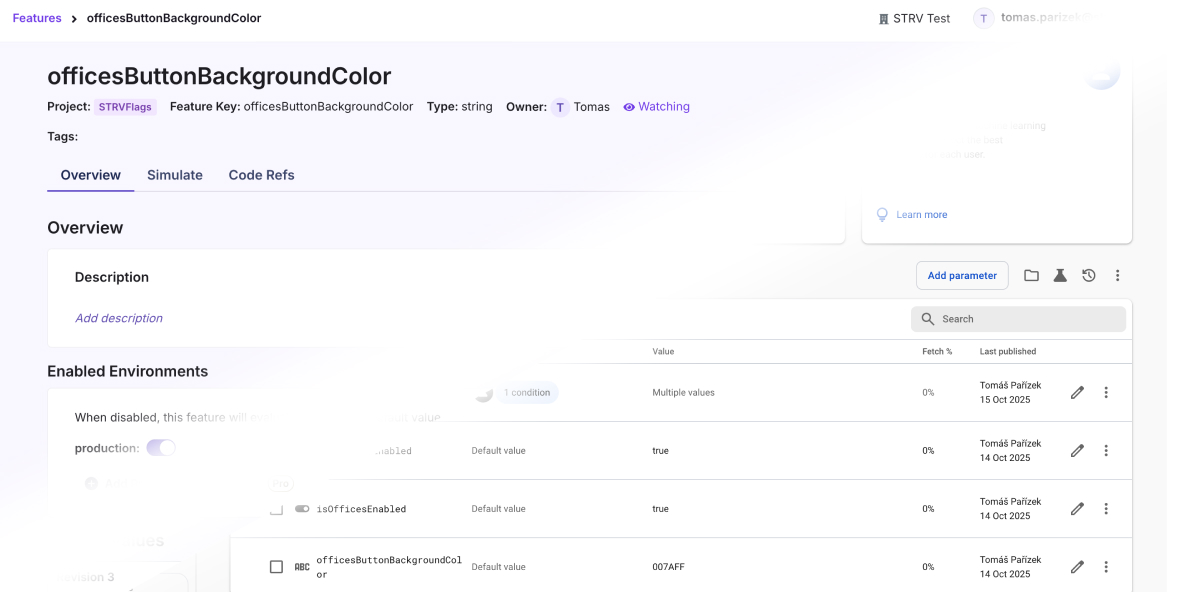Feature Flags on iOS: A Practical Guide to Faster, Safer Releases
19 Oct 2025Feature flags give iOS teams the power to change app behavior remotely without waiting for App Store approvals. They make it easier to experiment through A/B testing, release gradually, tune configuration values on the fly, and disable problematic features instantly. This enables faster iteration, safer releases, and smarter decision-making based on real data. In this article, we’ll look at how feature flags work, common use cases, ways to implement them, and how they fit into a broader system.

Feature flag basics
A feature flag is a remotely controlled value that your app reads at runtime to decide what behavior to use. Instead of hardcoding constants or shipping new builds for small changes, you can control the app dynamically.
Feature flags can have different data types:
- Bool — to turn features on or off
- Number — to control thresholds, limits, or percentages
- String — to select variants, layouts, or modes
- JSON — to define structured configurations
Using JSON is especially powerful because it allows you to group related flags together in a single place. This makes versioning cleaner, simplifies configuration updates, and allows you to decode the data into typed Swift structures for safe and convenient access in code.
Example
Feature flag configuration:
{
"showNewSection": true,
"onboardingVariant": "B",
"rolloutPercentage": 10,
"homeSections": ["hero", "news", "trending"]
}
Swift usage:
if Features.showNewSection {
NewSectionView()
} else {
LegacySectionView()
}
Use cases
Feature flags aren’t just about toggling features on and off. They open up new ways to release, test, and maintain your app without unnecessary App Store updates.
A/B Testing & Experiments
Feature flags make it easy to serve different variants of a feature or flow to different users and measure which one performs better. This leads to data-driven design and product decisions instead of relying on guesswork.
Gradual Rollouts
Instead of launching a new feature to everyone at once, you can enable it for a small percentage of users, monitor its stability, and ramp it up gradually. If something goes wrong, you can roll it back instantly without waiting for a hotfix.
Remote Tuning
Flags can store values like thresholds, timeouts, or strings, letting you fine-tune your app behavior remotely. It’s ideal for making quick adjustments based on feedback or experiments without resubmitting to the App Store.
QA & Internal Testing
Unfinished features can be hidden using flags and exposed only to testers. You can use user properties or external data sources—such as a database field or an internal employee role—to control visibility. This way, a feature can remain invisible to regular users in production while being fully accessible to internal teams on all environments.
Emergency Rollback
If a new feature causes problems in production, a single flag flip can disable it for everyone immediately. This minimizes user impact and protects your release schedule.
Building feature flag system
There are several ways to build a feature flag system. You can use a third-party service, or build your own lightweight setup.
Popular services:
- Firebase Remote Config – free and easy to set up.
- GrowthBook – open source with powerful experimentation tools.
- ConfigCat – SaaS with targeting rules and team collaboration features.
Custom setups:
- Static JSON hosted on a CDN — lightweight, fast, and simple.
- Backend-driven JSON — full control and perfect backend-frontend parity.
Implementing feature flags in Swift
Each project has its own architecture, so there isn’t a single implementation that fits all. In general, it’s best to:
- Have a dedicated service responsible for loading, storing, and exposing flags.
- Use an enum to define keys for type-safe access.
- Keep local defaults for when the device is offline.
- Allow dependency injection for testing.
Flags should be fetched when the app launches, and ideally, the UI should wait until they are loaded. This prevents visible changes while the user is interacting with the app. You can also create a macro or property wrapper to make flag access cleaner and more convenient for developers.
enum FeatureKey: String {
case showNewSection
case onboardingVariant
case rolloutPercentage
}
enum Features {
static var showNewSection: Bool {
FeatureFlagService.shared.bool(
FeatureKey.showNewSection.rawValue,
default: false
)
}
static var onboardingVariant: String {
FeatureFlagService.shared.string(
FeatureKey.onboardingVariant.rawValue,
default: "A"
)
}
static var rolloutPercentage: Int {
FeatureFlagService.shared.int(
FeatureKey.rolloutPercentage.rawValue,
default: 0
)
}
}
Flag lifecycle
Some feature flags should be treated as temporary infrastructure, not permanent fixtures. Each flag should have a clear owner responsible for it. Old or unused flags should be reviewed and deleted regularly to prevent clutter and technical debt. A lightweight approval process for creating and modifying flags helps keep the system clean and maintainable over time.
Backend-Synced Feature Parity
Using the same flag system for both backend and frontend ensures consistent behavior across your entire stack.
For example, a numeric flag can define a search radius for nearby users. The iOS app uses this value to draw a circle on the map, while the backend uses the same flag to query users in the database. There’s no risk of the two diverging.
Connectors
Some platforms let you connect your data sources directly. For example, you can use your application database to set conditions such as user roles, allowing you to target flags based on live data. This eliminates the need for maintaining multiple sources of truth.
Summary
Feature flags give iOS developers a powerful way to control behavior remotely, test ideas safely, and ship faster. They support A/B testing, gradual rollouts, targeted QA, and emergency rollbacks. A clean implementation with a small service, type-safe keys, and a good lifecycle process will make your system scalable and reliable.
If you have questions or want to discuss how to implement feature flags in your project, feel free to reach out to me on LinkedIn.